Hammock Gear Wanderlust Complete Kit for Hammock Tent Camping | First Look
An ultralight, low cost, no-nonsense, super easy to use, full hammock tent camping kit
The Hammock Gear Wanderlust Complete Kit for Hammock Tent Camping raises the bar for an ultralight, low cost, easy to use, complete hammock kit. In fact, it has the some of the best thought out features and easy to use components/hardware we’ve seen on any hammock setup. We’d guess that even a rank beginner might not have much trouble setting it all up. Yet it’s currently the lowest cost complete ultralight hammock tent kit.
And the final bar raise is that Hammock Gear is the only kit vendor that offers the option adding on down top and bottom quilts for a truly complete kit. This again is at a steep discount vs. purchasing separately.
What’s Great About the Hammock Gear Wanderlust
A no-compromise hammock kit that is inexpensive, durable, easy to use, but still light
- Least expensive pro-quality hammock kit on the market
- Easy to use, intuitive, knotless setup
- Only hammock kit with an upgrade option to add top and bottom quilts (also at a steep discount)
- Full 11 ft length for a comfortable hang (1 to 2′ longer vs. much of the competition)
- Strong, durable 1.6 oz/yd2, 40D fabric that supports up to 350 pounds
- Solid, full-sized, non-fiddly, user-friendly hardware that can be handled with gloves on
- All components come pre-attached and ready to go
Pro Tip: Read Why You Should Seriously Consider Hammock Camping. As our readers know, we believe hammock tents are a far better option vs. a conventional tent for wooded trails like the Appalachian Trail. I used a hammock guiding in WV this spring and will hammock camp again when guiding in Rocky Mountain Park later this summer.
Why a Hammock Tent Kit?
Complete kits are the hottest thing for Hammock Tent camping. In the past, the barrier to entry to hammock camping was huge. You practically needed a PhD to put together a good hammock setup from all the various, non integrated components, potentially from many vendors (many of the parts with strange names and unclear functions). To make matters worse, buying all those separate components to could get expensive and there was no assurance they’d work well together.
Hammock Tent Kits solve all of this. They come from a single manufacturer who carefully selects an integrated set of components. The kits usually come mostly assembled and are far easier to understand and use than the do-it-yourself hammock setups of the past. And since the manufacturer’s buy and sell in bulk you get savings. Usually about 25% off vs. buying items separately.
Quick Comparison | Ultralight Hammock Tent Camping Kits
- $230 | 40 oz | 11 ft | Hammock Gear Wanderlust Complete Kit for Hammock Camping
also an insulation (top & bottom quilt) add on option at a steep discount - $259 | 35 oz | 10 ft | Kammok Mantis Ultralight All-in-One Hammock Tent read Full Review
- $270 | 40* oz | 11 ft | Dutchware Complete Netted Hammock Package (1.6 Hexon fabric)
- $270 | 42* oz | 9 ft | Hennessy Hammock Explorer Ultralight Asym Zip Hammock
* These kits don’t include stakes. 4 Y-stakes added for “fair” weight comparison.
Hammock Gear offers and insulation add on option, also at a steep discount:
- $500 | 5.5 lb | 11 tt | Wanderlust Kit + Top and Bottom Down Quilts
Individual Components of the Wanderlust Hammock Kit
Hammock, Tarp (rainfly), Suspension, Hardware, Small Parts
Base Kit | What You Get
- Zippered Bug Net Hammock
- Ultralight Hammock Suspension: Continuous Loops, Ultralight Daisy Chain Carabiners (not visible in pic | stuffed inside with the hammock)
- Quest Tarp
- Knotless Tie-Out Package with LineLoc3 adjusters, Reflective Guy line, and Titanium Ridgeline Clips
- (4) Aluminum Y-Stakes
- Stake Stuff Sack
- Stuff Sack for storing everything together in one convenient place
- 40 oz Total Weight
MSRP: $311.94 KIT PRICE: $229.99 (25% off)
Optional Insulation Add On | What You Get
In addition to the Base Kit
- Economy Burrow (top quilt) Standard Length and Width 20 degree comfort rating: Moroccan Blue Outer / Black Inner
- Economy Incubator (bottom quilt) Standard Length 20 degree comfort rating: Moroccan Blue Outer / Black Inner
- 5.5 lb Total weight | Top Quit, Bottom Quilt, + Base Wanderlust kit above
MSRP: $671.84 KIT PRICE: $499.99 (25% off)
Zippered Bug Net Hammock
The anchor of Hammock Gear Wanderlust Kit is the Hammock Gear Zippered Bug Net Hammock (ZBN Hammock). It’s a full 11 feet long (1 to 2 feet longer than most hammocks). This longer length gives you a more room to get in the best position for a comfortable lie. The hammock is strong and durable, with 1.6 oz/yd2, 40D fabric that supports up to 350 pounds. You get a choice of five colors. The ZBN Hammock has full bug netting for bug protection. The bugnet has dual zippers on both sides allowing you to open it in any position. It can also be rolled back out of the way when there are no bugs. It is a gathered end hammock and comes with continuous loops and full-sized carabiners to attach to the Ultralight Daisy Chain suspension. The hammock has an attached self stuff sack that doubles as a small items storage pocket when the hammock is deployed.
19.7 oz | Zippered Bug-Net Hammock, Continuous Loops, Ridgeline, (2) Carabiners
Quest Tarp (rainfly)
The Quest Tarp is 11 feet long and generously sized to completely protect the hammock and a lot of gear below. It uses a minimal stretch silicone impregnated polyester 1.1 oz / yd² (20D) fabric (less tweaking when it rains) that also absorbs little water. The tarp comes with all cordage and hanging hardware pre-attached. The hardware is large and easy to use even with gloved hands.
- Color coded, reflective tie-out cords. Green for ridgeline, orange for corner (ground) tie-outs
- LineLoc3 line adjusters at all tie-out points
- Excellent ridgeline with large titanium clips for attaching to tree
- Available in Copper and Coyote Brown colors
13.5 oz | 11′ Quest Sil-Poly Tarp with LineLoc3’s, Glowire Guylines Attached
Suspension, Hardware, Small Parts
The hardware included in the Wanderlust Hammock Kit is large and intuitive/easy to use. You can even set up and the hammock and make adjustments with gloved hands. We especially like the titanium clip for the tarp ridgeline, and the carabiner/daisy chain webbing suspension setup. Finally unlike other kits that give you small/light stakes or none at all — the Quest comes with beefy, Y-stakes that are brightly colored (easy to find) and have reflective cord loops at the top (can see them at night).
Suspension (center of pic)
- Continuous loops (attach hammock to carabiner)
- Full sized, custom carabiner
- Ultralight daisy chain (for hanging hammock from tree)
Tarp Hardware (top and bottom of pic — attached to brown tarp)
- Color coded, reflective guylines. Green for ridgeline. Orange for tarp corner tieouts
- Large, easy to use titanium clip to secure ridgeline around tree
- Good size LineLoc3 cord adjusters
- Strong, brightly colored aluminum Y-stakes with reflective tie-out loops
Insulation Add On Option for Hammock Gear Wanderlust
High Quality Down Top and Bottom Quilts
Insulation Add On | Top Quilt and Under Quilt
Hammock Gear offers an optional kit upgrade to include high quality 800 fill power down quilts at very low prices. By adding a top quit and under quilt, you’ll transform your hammock to a suspended cocoon of plump warmth. In summary, it is the simplest, wamest, and most weight efficient way to hammock camp as the weather turns crisp.
Economy Incubator Bottom Quilt
- +20º F Comfort Rating
- Standard Length and Width
- 800 fill power DWR (Durable Water Resistant) Duck Down
- Available in Moroccan Blue only
- 22.5 oz
Economy Burrow Top Quilt
- +20º F Comfort Rating
- Standard Length and Width
- 800 fill power DWR (Durable Water Resistant) Duck Down
- HG double cord attachment does a better job of holding quilt in place than competition
- Available in Moroccan Blue only
- 25.5 oz
Conclusion | Hammock Gear Wanderlust
The Hammock Gear Wanderlust Complete Kit for Hammock Tent Camping is the least expensive, pro-quality hammock kit on the market. Not surprisingly it hits the sweet spot for, price, ease of use and low weight. It’s a hammock kit that will work for beginner and expert hammock tent campers alike. And Hammock Gear Wanderlust is currently the only kit with the option to add on down top and underquilts at a serious discount. We especially like its well thought out, intuitive to use hardware that makes setup a breeze.
That being said, hammock kits are the hottest part of the hammock tent camping market and there is competition. As such, Hammock Gear Wanderlust is tightly grouped with a few other hammock tent camping kits: Kammok Mantis Ultralight All-in-One Hammock Tent and Dutchware Complete Netted Hammock Package as well as original hammock tent camping kit, the Hennessy Hammock Explorer Ultralight Asym Zip Hammock. We think all things considered the Hammock Gear Wanderlust has the edge, but each of the other hammock tent kits has one or two points it its favor.
Finally, to put things in perspective, if you go the “assemble the kit yourself route,” you can assemble a lighter hammock kit, albeit a lot amount more expensive. For example, a netless hammock with 1.1 oz fabric, an expensive Dyneema tarp, and ultralight custom suspension might weigh around a pound. But it will cost you dearly, won’t be as strong or durable as the Hammock Gear Wanderlust kit, and it won’t be as easy to use. We’re guessing that most folks will be much happier with the Wanderlust or another high quality kit.
What’s So Great About Hammock Tent Camping?
As our readers know, we believe hammock tents are a far better option vs. a conventional tent for wooded trails like the Appalachian Trail. As such, we take them on almost every trip in the Eastern US and even areas like Rocky Mountain National Park. You can read more about this in our 7 Reasons Why Hammock Tent Camping is Fantastic | How To Get Started. In summary, some advantages of hammock tents for Eastern US and most other wooded areas are:
- Huge increase in available campsites vs. tents – stop and camp where you want. No need to worry about uneven, sloping, rocky, muddy ground.
- Sleep comfort and sleep quality – sleep the same great way each night regardless of the ground below you
- Fast easy setup – no poles and very little staking assembly required
- Leave No Trace – no need to clear ground of debris, or crush pants/ground below
- More Solitude – no need to camp in popular, heavily impacted campsites with noisy campers
- Protection against rain & ground water – you sleep above it, not in it (many established campsites become small lakes in heavy rain)
Hammock Camping — The Basics
Derek Hansen, author of The Ultimate Hang, is an advanced hammock camper and excellent illustrator. Here’s a quick illustration about the essentials of hammock camping.
Disclaimer
This post contains affiliate links. If you make a purchase after clicking on the these links, a portion of the sale helps support this site at no additional cost to you. I do not receive compensation from the companies whose products are listed. For product reviews: unless otherwise noted, products are purchased with my own funds. I am never under an obligation to write a review about any product. Finally, this post expresses my own independent opinion.
Leave a Reply
Want to join the discussion?Feel free to contribute!

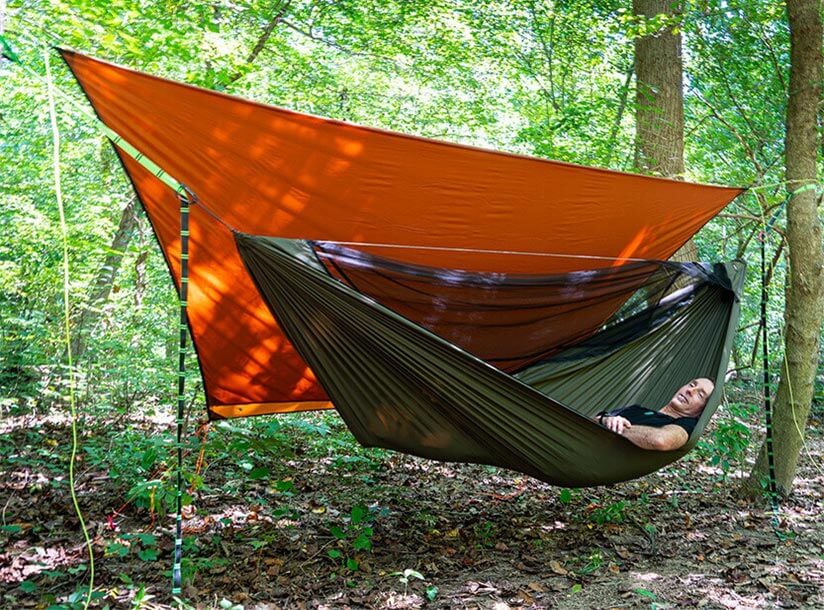
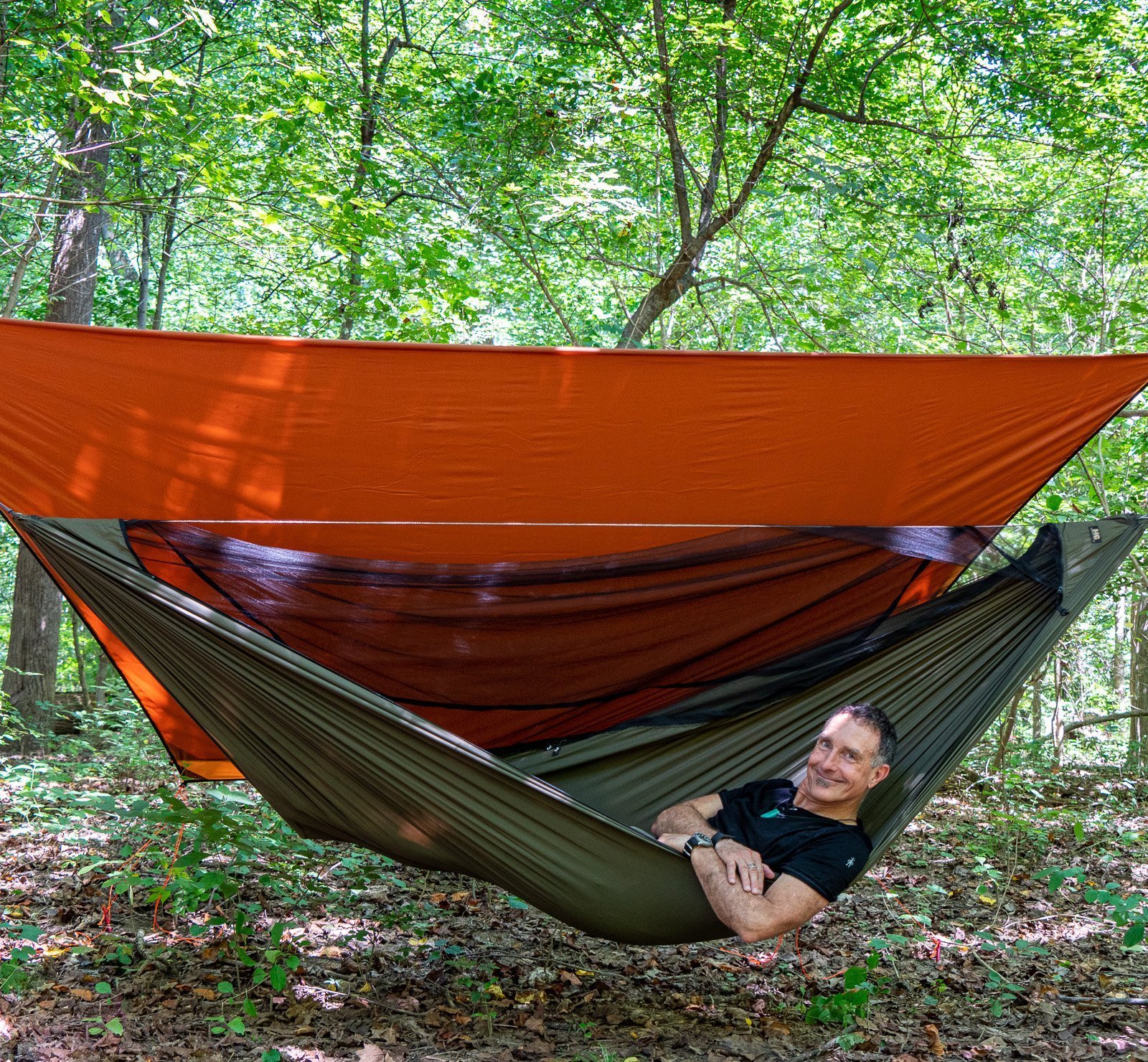
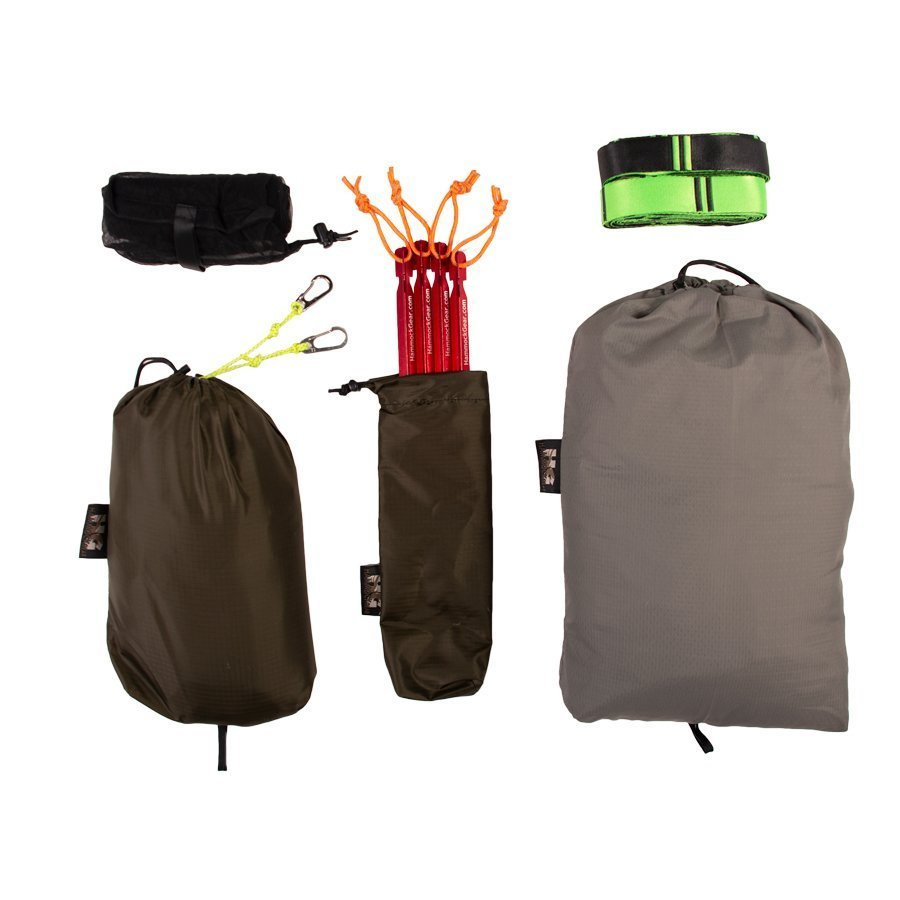
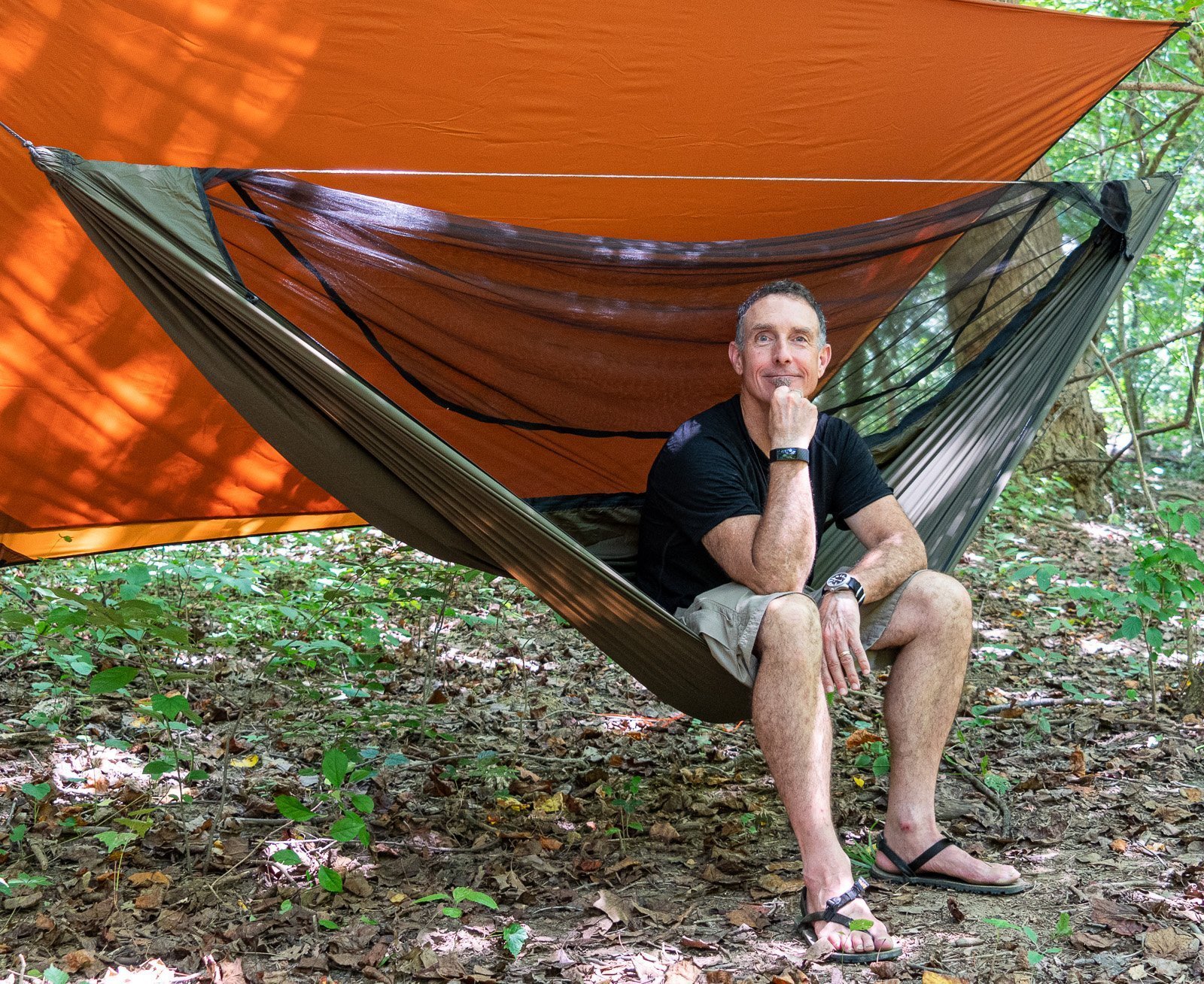
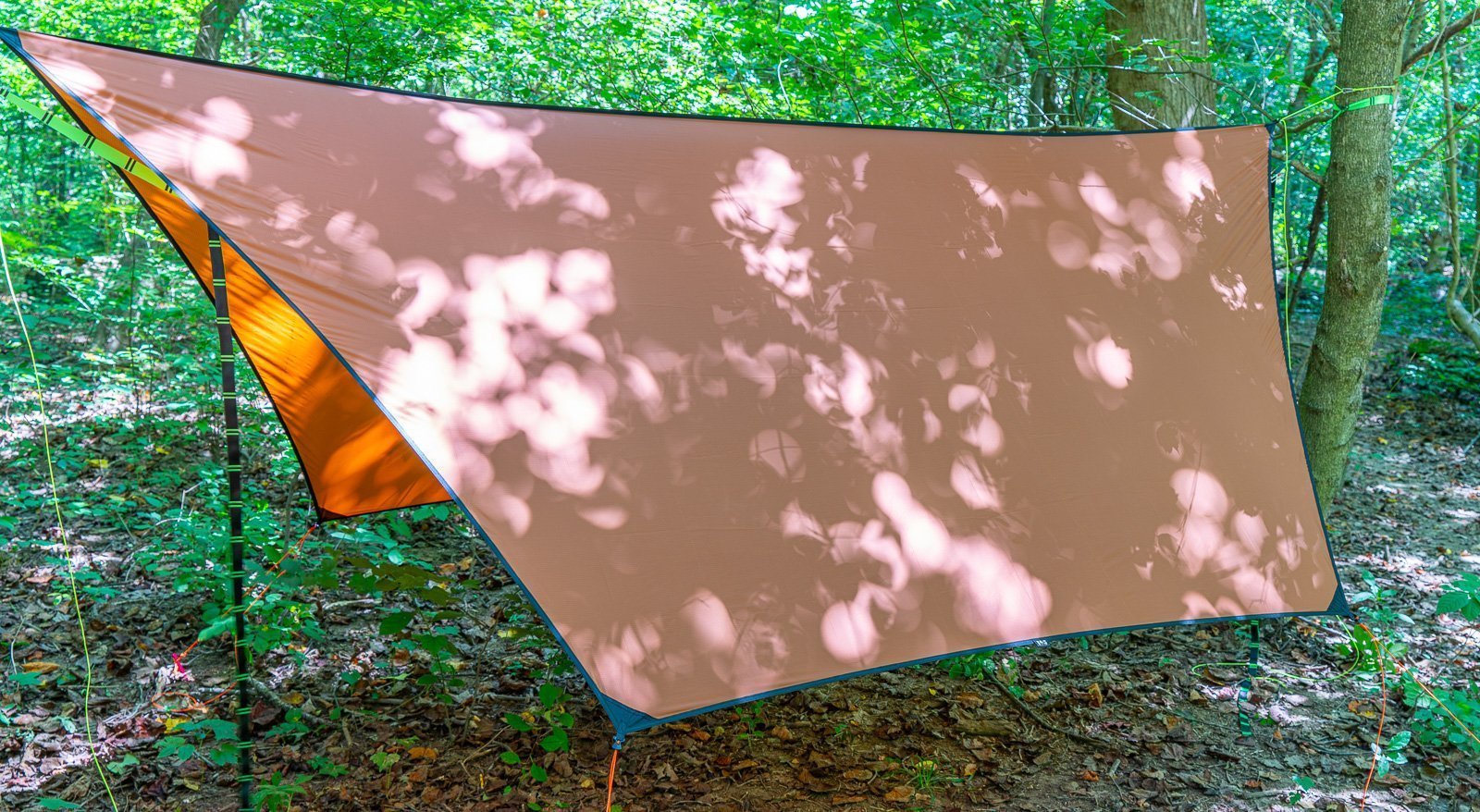
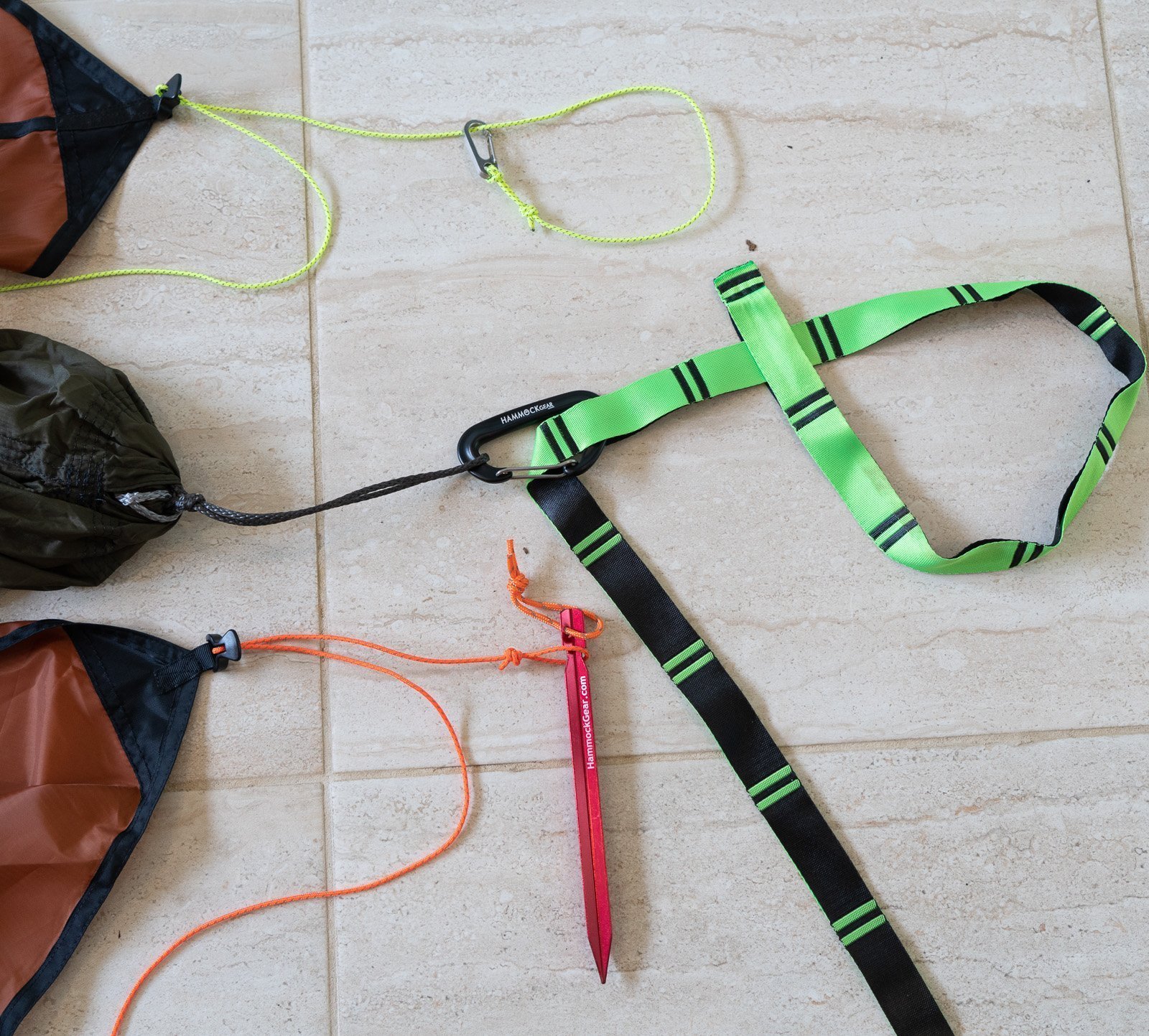
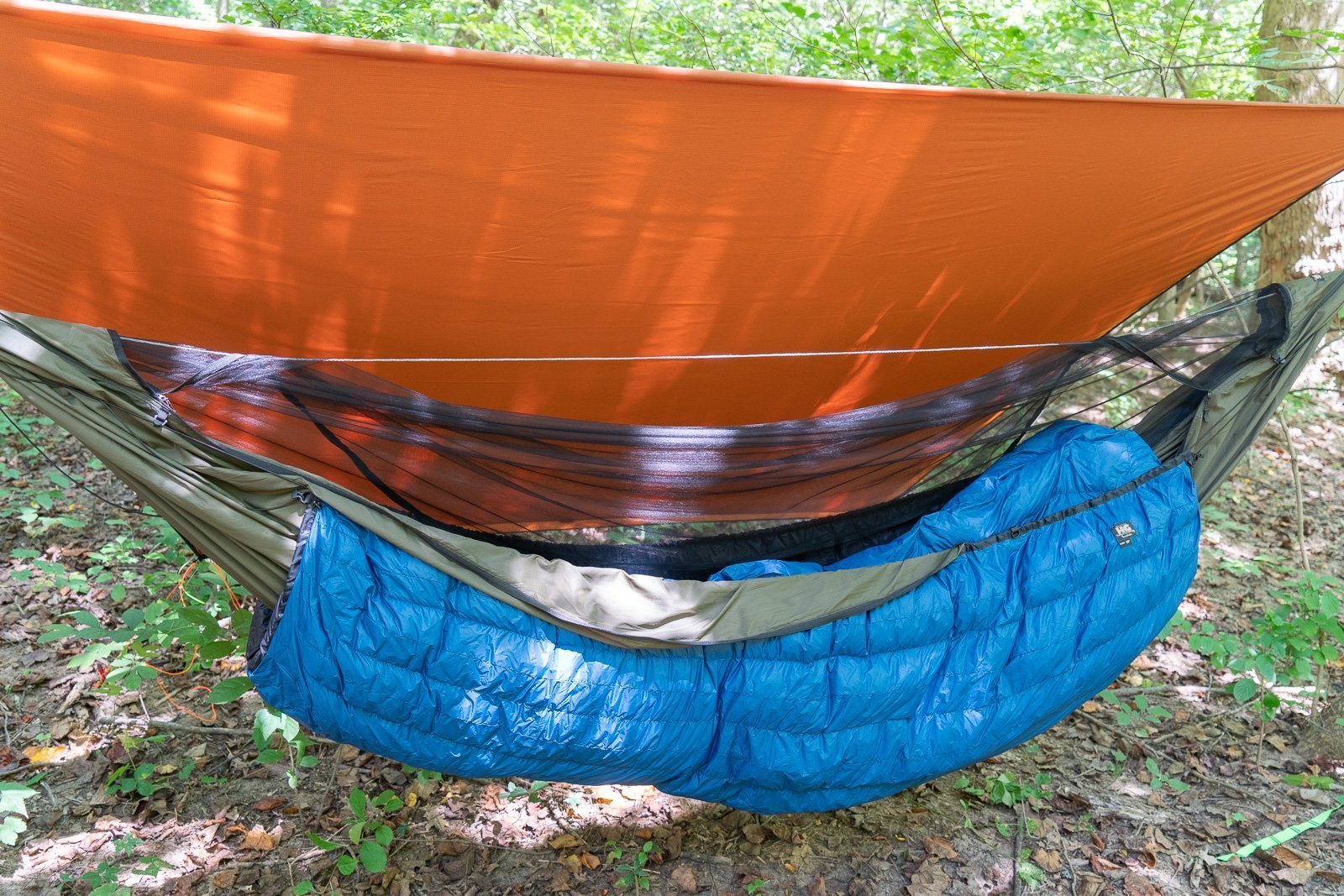
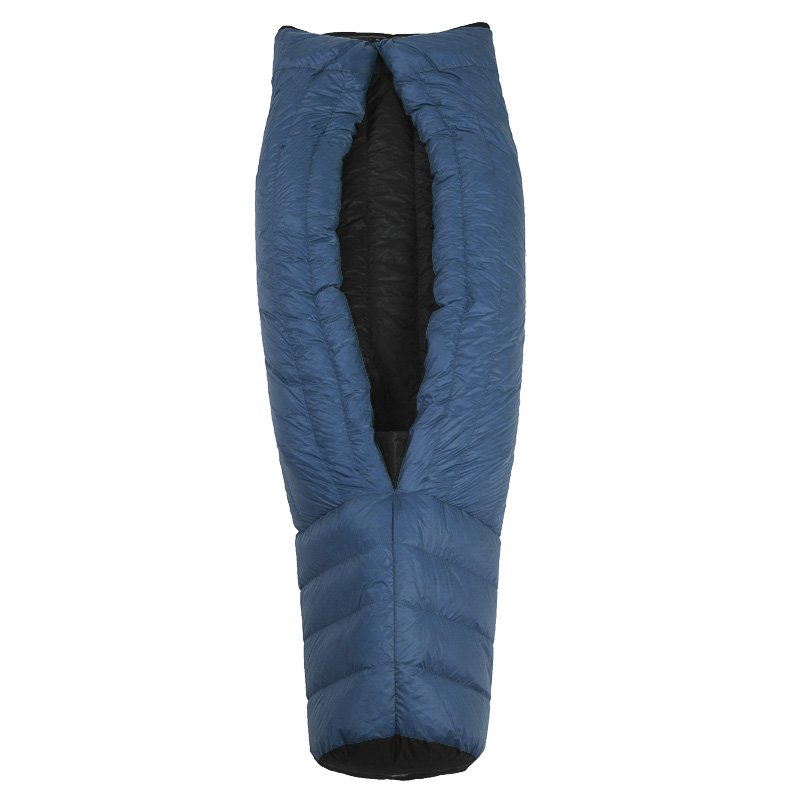
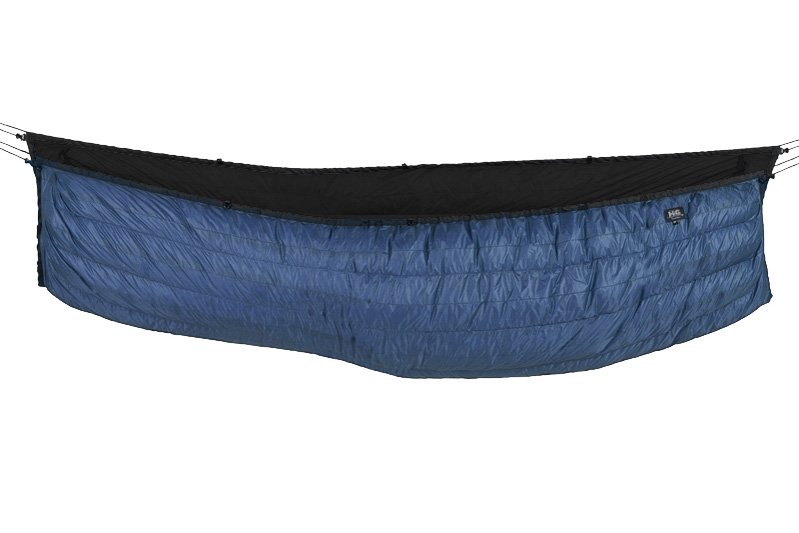
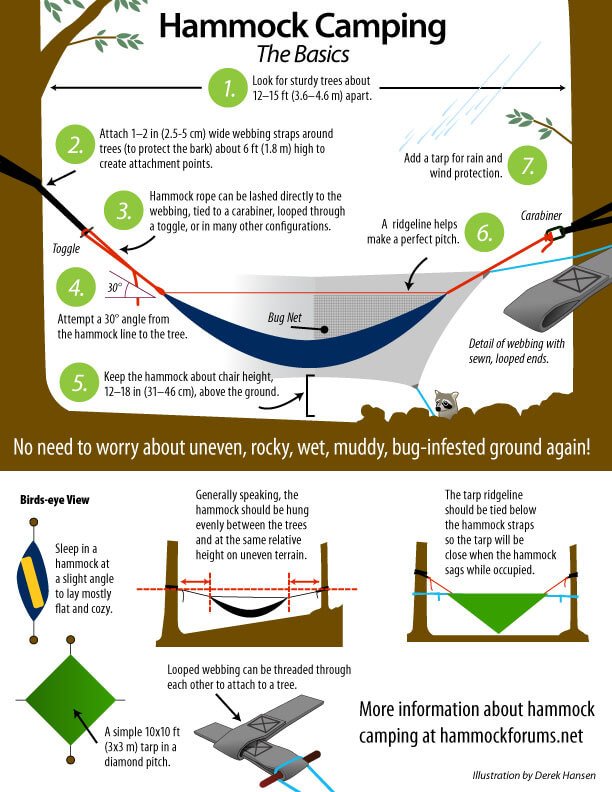


Hi Alan,
Nice review.
I already have an enigma 20 degree quilt.
Is the under quilt essential or can I scrape by with an insulated pad for now?
October in mid Atlantic.
This has been extremely helpful as someone new to camping/backpacking hammocks but one thing I’ve yet to come across is how well the UQ and TQ pack down. Since the quilts are both down I’m assuming they compress fairly well but any idea how many liters they compress down to so I know how much space to expect them to take up?
Good Q Nate, but we haven’t provided volume compression for a a couple of reasons. 1) the amount of down varies wildly with temperature ratings, and 2) it also varies wildly by how hard you actually compress it. As such it would be time consuming and nearly impossible to come up with a standard repeatable volume. But as a general rule at TOP Quilt + an Under Quilt is going to be more volume than and individual down sleeping bag of equivalent warmth. And probably a bit more volume than the sleeping bag plus a NeoAir pad. So expect them to take up a bit more pack volume. And again we don’t like to overstuff our quilts or sleeping bags. Warmest, -alan
Alan,
Thanks for the quick response. The MLD was not even on my radar because it was frameless. I am a little worried with my inexperience that I would need a frame. I have been looking at the ULA Ohm which I believe has a main compartment of 34L, the Mariposa 60 with 36L main compartment and the HLD 2400 series with 40L main compartment. This is how I came to my original question. On top of the hiking potentially long distances for multiple days, I plan to stick fly fishing poles and fishing gear (among other things) in packs for those random weekends so gettin off trail is a possibility. Do you think a frame is overrated if you can keep the load that light? Do you think MLD would be a good pack over those, or would you recommend any of those bags over the others? Working remotely can have its downfalls when you get sidetracked !
Thanks for your time!
I think if you keep your load around 20 lb, you will be OK with a frameless pack. Over that you will likely be more comfortable with a frame. As to fly fishing, I would recommend looking at tenkara when backpacking. That will bring your fishing gear weight to around 8 oz. Rod will and gear will fit in your pants pocket. Best, -alan
Alan,
I am very new to hiking (did a few Adirondack 46ers recently) but with my extra free-time lately I have been diving deep into your website (it’s awesome)! I am very into the idea of extended ultra light hiking and have gone over your 9lb base weight article many times. My question is; Is it practical to carry 2 quilts and a hammock at roughly 5.5lbs in a backpack that at max has 60L capacity? I know some of the ultra light bags main compartments are between 33 and 40L. At already 7.5 lbs between a bag and a sleep system, it seems to be very hard to get your base weight even under 10lbs. Any words of wisdom would be much appreciated!
Thank you
Hi Jasen, good Q. If you are hammock camping it’s better to get a larger capacity pack to hold both quilts. And again, I don’t like to super compress down — not a great idea. So a pack in the 50-60L is ideal. But that does not mean that it needs to be a heavy pack. The MLD Exodus will do just fine so long as you don’t get much heavier than a 20 lb load (with food, fuel, and water). You should still be able to get your BPW under 10 lbs assuming you have down quilts. Hope this helps. Wishing you some great hiking this year. Warmest, -alan
Cool! Thanks a gain for your site and all the info your site provides on equipment and options.
regards
Scott
Our pleasure!
Pretty cool hammock set up! Thanks for doing the video and research. I have a question on how well the tarp works in a rainy situation with wind? It sure seems like a lot of water can enter the ends where the tarp ties off. Does the hammock/tarp work as well as a tent in rain and wind?
I sure like the hammock setup better than the tent for hiking. Seems like a no brainer where I hike.
Hi Scott. Good Q. The short answer is yes an 11′ tarp should do you fine. I have never gotten significantly went under mine. The longer answer: A few things about hammock camping. Since you are in the woods (need trees to hang from) there generally is not the same strong, full-force winds as being out in the open. That is, the trees and vegetation do a good job of mitigating much of the wind. As such, I have had very little issue with a generous hex tarp (like the Quest in the kit). But do make sure that your suspension has a “rain break” (the carabiner in the HG kit counts as one). And generally folks favor their head a bit under the tarp. While tarps with doors seem like a good idea, but generally they are far more of a pain to setup and use for the benefit (if any) that they provide. Hope this helps and wishing you a great year of hanging. Warmest, -alan & alison.